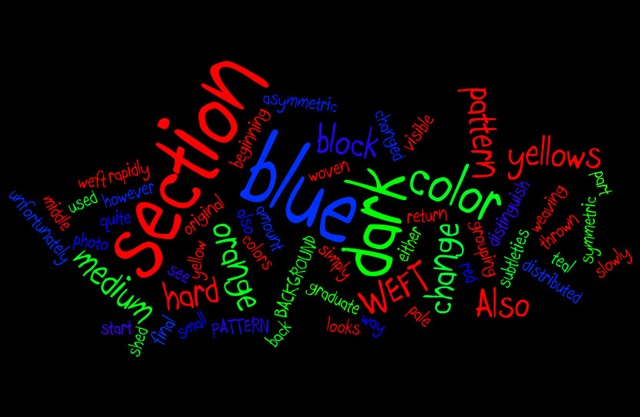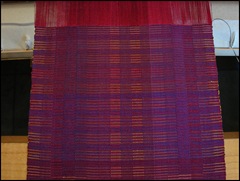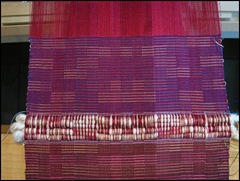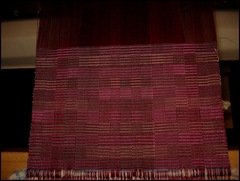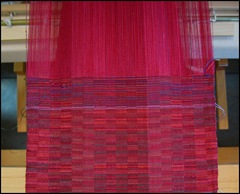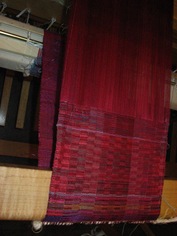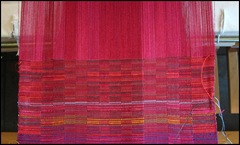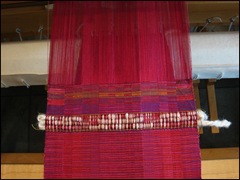I mentioned the other day how I have been procrastinating getting the art piece ready for hanging. I finally decided I had to drag out an old trick. I picked one very very small thing to do, in this case, finding the saw to cut the wooden rod. And I made an appointment with myself to do it: 10:00 this morning. The trick worked. I have now cut the rod to what I think is the right length, sanded it, and applied two coats of stain. Tomorrow I will put on the first coat of protective finish.
A book I have just finished reading helped to this point. The book is by Phil Cousineau and is called Stoking the Creative Fires: 9 Ways to Rekindle Passion and Imagination. Cousineau is writing about the creative journey, a journey he divides into three parts. The first part is about inspiration, the source of the creating, how and where to find it. The second part is about the work process itself. And the last part deals with handling issued centering on the finally created piece. Go here to find out more about the book
MAKING TIME
The chapter which resonated the most with me was on time: "Seizing the Moment." In this chapter Cousineau includes an exercise called "Five Simple Ways to Make Time." The following two (found on page 72 of the book) are the ones that stopped me
- Turn distractions into free time.
- Every day do two things you've been avoiding.
It is the second one that helped me realize that needed to make the appointment with myself to take the first beginning step in finishing up the wall hanging. The other thing I am going to do today that I have been avoiding is to make an appointment with the vet for my cat's annual physical. Whoops, not weaving related!
SOME CURRENT DISTRACTIONS
Dealing with distractions, however, does not seem to be quite so easy. I love my distractions: The computer. The internet. Email. Blogs. Blogs. Blogs. (Also Ravelry--except I'm not particularly fond of that so it is not really a distraction.) And because I love them, it is hard to think objectively about them. It is hard to ask the question: how much are these taking away from the things I really want to do? The question is hard to ask because I know the answer and i don't like the answer. Instead I readily give the easy answer: I don't watch TV and I barely read the newspaper, so what's wrong with all this internet activity? What is wrong, is that all this internet activity is taking lots of my precious time away from the activities that really matter to me.
WEAVING BLOGS
Blogs. I am not going to stop blogging. Nor am I going to stop reading blogs. Weaving blogs, that is. I need to write about what I am doing and thinking about in terms of weaving because doing these things helps to keep me focused. And I need the weaving community provided by the blogs because this community breaks the isolation. No, I am not going to stop writing nor am I going to stop reading weaving blogs. These are activities that help to sustain me. They are activities that I give me great pleasure.
OTHER BLOGS
But............I must confess that I subscribe to a lot of non-weaving blogs. Some are fiber-related. Some are not. It is so easy for me to subscribe and read lots of blogs because I use Bloglines, a blog reader which makes for great efficiency in reading blogs. To find out more about Bloglines, go here. But now when I read a non-weaving blog I ask myself what I would lose if I unsubscribe. And for the most part I unsubscribe. Having been doing this for a couple of days I am down to 157 feeds. No, that is not a typo. I will continue to get rid of a lot more. And a lot of them are very inactive, but many are not. So I will continue onward chopping off blogs.
EPISCOPAL BLOGS
But I have not mentioned one of my most awful time wasters. I am an Episcopalian. An active Episcopalian. Episcopalian born and bred. The Episcopal church is in a dreadful turmoil with the Anglican communion, of which it is a member. Because of where I live, the intensity of the conflict and the fear of what is going to happen is for me personally very very high. So I read daily four or five major blogs that I like which cover the latest of what is going on.
For awhile I limited myself to reading them only on Fridays. Doing that freed up an amazing amount of time. I am thinking of compromising. I think I will read my one favorite blog daily, the others once a week. I've already failed at this today.........
EMAIL
Email. Over the years I have ended up subscribing to a lot of retail email notifications. I do buy a lot on the net and it is just very easy to click the little box, or not unclick it, as the case may be. So today I have begun to attack that time waster For almost every retail email I am getting I am immediately unsubscribing.
And then I have recently added a couple of lists from Yahoo, but they have turned out to be neither useful nor entertaining so I will unsubscribe from them.
I know I could do better. I know I am probably keeping some of the distractions that I shouldn't. I know, too, that I could put time limits on my internet activity. But I have made a start. And this, for now, this is where I am.
Related Posts:
Resistance
"Cut Back on Distractions"
Weaving and Blogging
© 2008
 together.
together.